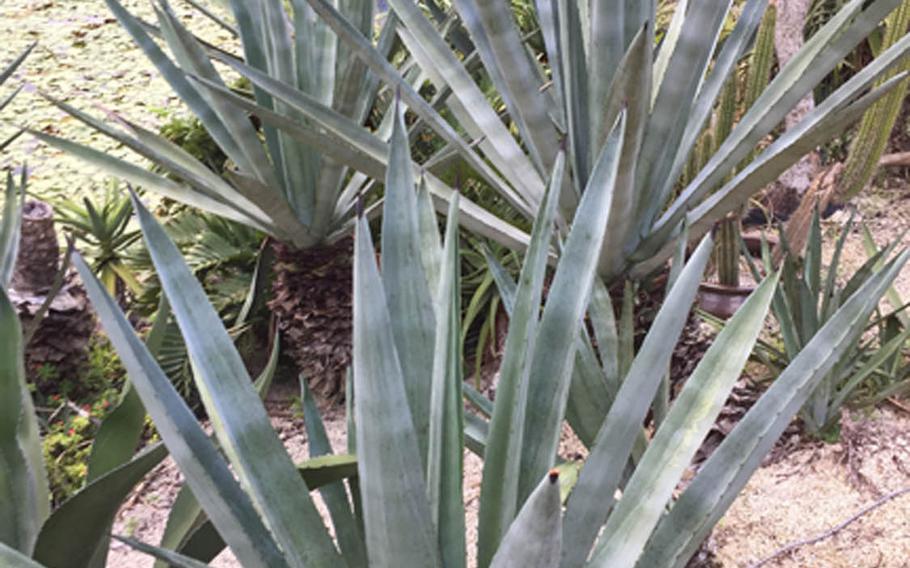
An agave plant at Okinawa's Southeast Botanical Gardens. (Matthew M. Burke/Stars and Stripes)
It’s important to take time to stop and smell the roses every once in a while, as the old adage suggests, and Okinawa’s Southeast Botanical Gardens offer the perfect opportunity. At nearly $14 for an adult ticket, the gardens are a bit pricey. For your ticket, you get spacious, well-manicured grounds to walk and explore, marked by beautiful flowers and interesting plants and animals. There are also places for the kids to play, as well as places to sit and reflect, if the mood strikes you. It is one of Okinawa’s most relaxing and visually stunning attractions — and one of the only places I know where you can get frisked by an overenthusiastic capybara. After purchasing a ticket at the front gate, visitors may choose which of two distinct gardens to visit first — the water garden or the botanical garden. The two are bisected by a park road. The water garden offers meandering roads and paths through palm trees, over slowly sloping grass-covered hills and around ponds and water features. While you wander, you may see volcanic rock, ducks, flowers and interesting plants like the spiky agave. Gazebo-like structures offer picturesque places to sit, relax and take it all in. Small trickling streams and lovely bridges over the water add to the beauty. The park’s lotus weren’t in bloom, yet blood red and striking yellow flowers accentuated the palette greeting visitors on a recent day in late August. Southeast Botanical Gardens’ four iconic plants and trees on display are the alexander palm, which can only be grown in greenhouses in mainland Japan; the baobab; the lotus; and the dragon blood tree. The alexander palms are straight, extremely tall and line the road. The baobab, known as the treasure tree, originated in Madagascar, according to the park’s website. Its leaves can be eaten as a vegetable and its roots are often used in medicine. The lotus is known for its beautiful pink and white flowers, which cover the park’s pond in the early summer months, and the dragon blood trees produce a dark red fruit. The water garden also has an island built on top of its Omoiyari Pond called Goat Island. As its name implies, the man-made platform in the middle of the pond features an assortment of goats. They are friendly and don’t mind being petted. However, like all the animals at the gardens, they are accustomed to being fed (the park sells special treats for the animals), and they will aggressively try and get into your hands, bags and pockets looking for food. Several times a day, visitors are allowed into a capybara and squirrel monkey petting zoo. The animals coexist together inside. Southeast Botanical Gardens often have different animals in the same enclosures, an interesting experiment in animal socialization. The petting zoo was a true treat for the kids. They giggled with glee as the tiny monkeys approached them to take treats out of their hands, then swung on ropes into trees and onto the bars of the large enclosure. The capybara was endearing and also open to being petted, but it chased the kids around after the lettuce ran out, looking for more. The water garden also offers a guinea pig petting zoo that features bridges and towers. Children were delighted to see the creatures scamper back and forth and stick their faces out from the deck to be petted or to look for food. Nearby, rabbits and chickens run around in the same enclosure. Large, seemingly ancient turtles munched lettuce next to a capybara crunching on greens. The park also had mice, snakes and even scorpions on display. The botanical garden across the street had a boar and a pig in the same enclosure, a slew of noisy piglets running around and more goats. They also featured magnificent herb and fruit gardens, more palms, and baobab and giant pothos plants lining the streets. In the summer, the park erects a pool in the botanical garden for the kids to swim in, and special events such as fishing and night adventures take place. The park’s restaurant is popular with locals and known for its high-quality buffet. A cafe onsite serves tasty homemade gelato. If it’s just animals you’re after, Okinawa’s zoo has a wider variety, but Southeast Botanical Gardens’ petting zoos are unsurpassed. But if you’re a fan of lovely, tranquil scenery, there are few places as beautiful to take a walk on Okinawa. Come visit, and when you do, take your time and stop at every “rose” you see.burke.matt@stripes.com
Southeast Botanical Gardens Location: 2146 Chibana, Okinawa City, Okinawa Prefecture 904-2143 Times: Open 9 a.m. to 6 p.m., Sunday through Thursday; 9 a.m. to 10 p.m., Friday, Saturday and days preceding a holiday. Costs: 1,500 yen (about $13.60) for adults, 1,000 yen for high school students, 500 yen for elementary and junior high, and free for children younger than 6. Discounts available for groups of more than 20 people. Food: There is both a restaurant and a café on site. The restaurant, called Peace, is popular with locals and opens for lunch at 11:30 a.m., stays open for tea and light snacks before transitioning to dinner service at 6 p.m. The café offers drinks and gelato. Information: 098-939-2555; www.southeast-botanical.jp/en